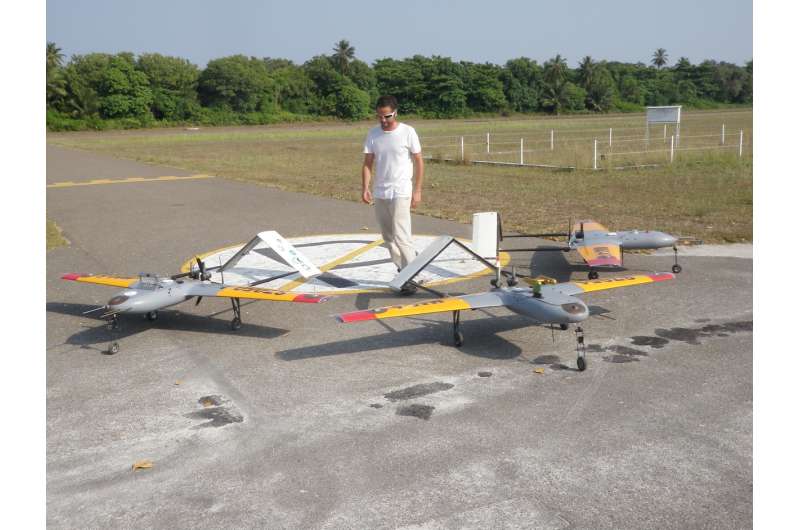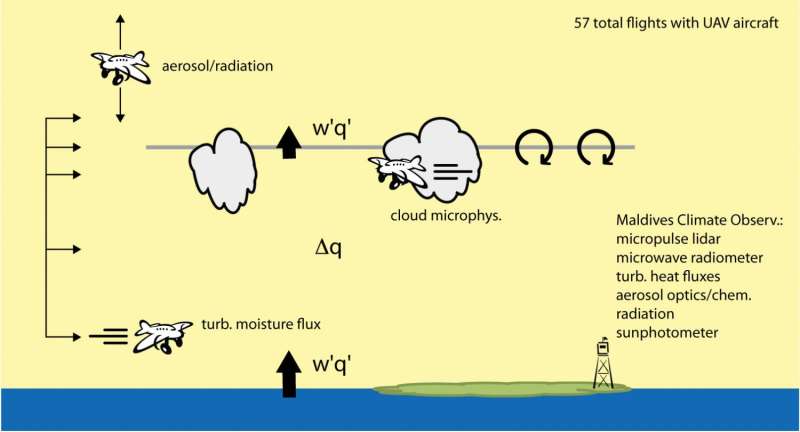New insights into how black carbon aerosols impact the atmospheric boundary layer

It is widely known that black carbon, or soot, aerosol particles emitted from South Asia are spread across the northern Indian Ocean during the winter monsoon season.
These masses of air pollution adversely affect human health and have been shown to play a significant role in regional and global climate change, second only to carbon dioxide.
New research led by Eric Wilcox, Ph.D, an atmospheric scientist at Nevada's Desert Research Institute (DRI), outlines new insights into how these high concentrations of black carbon aerosols may also reduce atmospheric turbulence and enhance relative humidity near the Earth's surface, exacerbating both human health impacts and extreme weather events.
The study, "Black carbon solar absorption suppresses turbulence in the atmospheric boundary layer," appears this week in the early edition of the journal Proceedings of the National Academy of Sciences (PNAS).
Utilizing a fleet of unmanned aerial systems (UAS) with specialized instrumentation developed by the Scripps Institution of Oceanography at the University of California San Diego, Wilcox and his colleagues for the first time measured the atmospheric turbulence and vertical flow of latent heat above the ocean's surface up to altitudes of 3,600 meters (12,000-feet) - an area of the atmosphere commonly known as the marine boundary layer.
"To completely understand the effects of these harmful aerosols on our climate and the modifications they cause to clouds and weather systems originiating in the boundary layer," explained Wilcox, "you have to first understand the turbulent dynamics of the air where the aerosols reside and the clouds form."

"The climate science community has long debated the impact of turbulence in the boundary layer and our research team set out to directly measure that, which hadn't been done before," he added.
The UAS flights were performed in 2012 at various altitudes for distances of up to 10 miles, averaging over three hours. They originated at Hanimaadhoo in the northern part of the Maldives, a country made up of a string of islands south of India.
Specialized instrumentation aboard each aircraft measured turbulent kinetic energy (TKE), aerosol particle concentration, black carbon concentrations, cloud droplet size and density, and temperature fluctuations. The turbulent flux measurement instrument package was developed by Rick Thomas, Ph.D, during his time at Scripps as a postdoctoral researcher. Thomas is currently a research fellow at the University of Birmingham, School of Geography, Earth and Environmental Sciences.
Aircraft data was combined with ground measurements obtained at the Maldives Climate Observatory on Hanimaadhooa, a background site for atmospheric and climate studies in South Asia.
The Maldives is the lowest country in the world, with an average natural elevation of 1.5 meters. The country is expected to be one of the first substantially affected by sea-level rise, a key consequence of global warming.
This study advances pioneering research performed nearly 10 years prior with the same lightweight UAS and led by Veerabhadran Ramanathan, Ph.D, a distinguished professor of climate and atmospheric sciences at Scripps.

During the Indian Ocean Experiment (INDOEX) Ramanathan and his colleagues first discovered that black carbon aerosols were a potent absorber of sunlight and therefore a major contributor to global warming.
"The finding that black carbon warming of the boundary layer is suppressing turbulence is a cause for concern," explained Ramanathan, "since turbulence is one of the important ways by which pollution near the surface is transported away from human exposure. Suppressing it can increase ground level pollution."
The study also illustrates the continued advancement of UAS as valuable scientific research tools and showcases the strength of UAS to simultaneously measure multiple components of the same cloud system while only disturbing the cloud to a minor degree, added Ramanathan.
Furthermore, said Wilcox, the unique instrumentation developed as part of this study can be applied to existing and planned UAS applications in Nevada and across the West. Most notably, scientific efforts to better understand drought and the dynamics of winter precipitation events in the Sierra Nevada.
The authors also acknowledge that further study is needed to understand how the absorption of black carbon aerosols in the boundary layer may also impact the formation of cumulus (storm) clouds and higher elevation atmospheric events.
More information: Eric M. Wilcox et al, Black carbon solar absorption suppresses turbulence in the atmospheric boundary layer, Proceedings of the National Academy of Sciences (2016). DOI: 10.1073/pnas.1525746113
Journal information: Proceedings of the National Academy of Sciences
Provided by Desert Research Institute




















